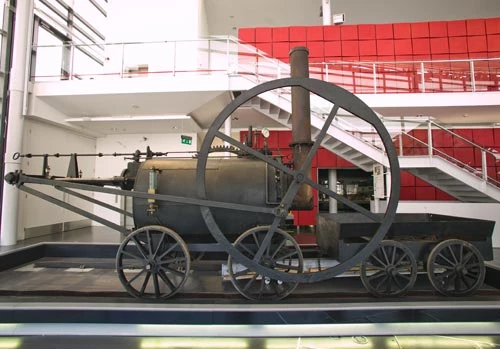Locomotif stêm Richard Trevithick
Yr atgynhyrchiad o'r locomotif yn ei gartref presennol, Amgueddfa Genedlaethol y Glannau.
Loco Penydarren
Ar 21 Chwefror 1804, rhedodd y daith rheilffordd gyntaf am 9 milltir o weithfeydd haearn Penydarren i Gamlas Merthyr–Caerdydd, gan gyrraedd cyflymder o bron pum milltir yr awr. Aeth nifer o flynyddoedd heibio cyn bod trenau stêm yn dod yn fasnachol ymarferol, ond does dim amheuaeth nad Trevithick yn hytrach na George Stephenson oedd gwir dad y rheilffyrdd.
Ym 1803, aeth Richard Trevithick i weithio gyda Samuel Homfray, perchennog gwaith haearn Penydarren ym Merthyr Tudful. Roedd Homfray'n ymddiddori’n fawr yn yr injans gwasgedd uchel yr oedd y dyn o Gernyw wedi eu datblygu a’u defnyddio yn ei injans ffordd.
Anogodd Homfray Trevithick i ymchwilio i’r posibilrwydd o osod injan o’r fath mewn locomotif ar y rheilffordd newydd rhwng Penydarren a glanfa’r gamlas yn Abercynon.
Richard Crawshay
Mae’n debyg bod Trevithick wedi dechrau gweithio ar y locomotif yn hydref 1803, ac erbyn Chwefror 1804 roedd wedi ei gwblhau. Yn ôl bob sôn, roedd Richard Crawshay, perchennog y gwaith haearn cyfagos yng Nghyfarthfa, yn amheus iawn o’r injan newydd. Betiodd ef a Homfray 500 gini’r un gyda Richard Hill, o waith haearn Plymouth, p’un a allai’r injan dynnu deg tunnell o haearn i Abercynon a thynnu’r wagenni gwag yn ôl wedyn.
Aeth yr injan ar ei thaith gyntaf ar 21 Chwefror, a disgrifiodd Trevithick y daith yn fanwl:
‘... ddoe aethom ar ein taith gyntaf gyda’r injan, gan dynnu deg tunnell o haearn mewn pum wagen, a saith deg o ddynion yn teithio arnynt ar hyd y ffordd ... tra ’roedd yr injan yn gweithio, teithiodd bron i bum milltir yr awr; ni roddwyd dŵr yn y boeler o’r cychwyn hyd ddiwedd y daith ... defnyddiwyd dau ganpwys o lo’.
Yn anffodus, torrodd bolltyn ar y daith ’nôl a barodd i’r boeler golli dŵr, felly bu’n rhaid gwneud y tân yn llai ac ni chyrhaeddodd yr injan Benydarren tan y diwrnod canlynol. Rhoddodd hyn reswm i Crawshay honni na chyflawnwyd y daith fel y cytunwyd — ond ni wyddom a fu pen ar y mwdwl!
Y gwir oedd fod yr injan yn rhy drwm i’r cledrau, ac fe’i defnyddiwyd yn ddiweddarach fel injan sefydlog i yrru morthwyl gefail yng ngwaith haearn Penydarren.
Locomotif replica
Adeiladwyd y locomotif replica yn yr Amgueddfa gan ddilyn cynlluniau a dogfennau gwreiddiol Trevithick (sydd bellach yn Amgueddfa Genedlaethol Gwyddoniaeth a Diwydiant). Cafodd ei chwblhau ym 1981, ac yn union fel yr injan wreiddiol, fe dorrodd ar ei rheiliau!
Allwn ni ddim orbwysleisio pwysigrwydd locomotif Trevithick. Ym 1800, ar garlam wrth farchogaeth oedd y cyflymaf y gallai dyn deithio dros dir. Ganrif yn ddiweddarach roedd rhwydwaith reilffordd yn cyrraedd cyfran helaeth o'r byd gyda threnau’n teithio’n gyson ar gyflymder o chwe deg milltir yr awr. Yn ne Cymru yn Chwefror 1804 gwelwyd cymal cyntaf y daith honno a weddnewidiodd y byd.
The Penydarren locomotive - Steaming Days
Ffilm fer yn dogfennu blynyddoedd cynnar y replica o locomotif Richard Trevithick yn Amgueddfa Genedlaethol y Glannau, Abertawe.


sylw - (23)
Nothing better than steam engines andRichard Trevethick getting his recognition!
Than’ you aga8n!
replica at the National Waterfront Museum of Wales. In the 1960s when I was school , there was a large model (now hidden in the basements) in Cyfartha Museum of what
was thought to be the Penydarren but was actually the Coalbrookdale Locomotive ( made by Airfix as Andrew Longdon's comment ) in the 1960s. As John Hellin points out,
the National Railway Museum at York puts emphasis on Stockton and Darlington 1825 and Stephenson's Rocket 1829, not Richard Trevithick and Merthyr Tydfil 1804.
Even in 1962, I remember we had some debate as to where the front of the Penydarran locomotive was - the chimney end or the flywheel and where the fire box was
and whether Terence Cuneo's 1962 rendition is as it was.
Norman Chang, London and Merthyr Tydfil born.
Thanks guys.
Hi Andrew,
Thank you for getting in touch with us. A number of our staff are currently on furlough, including my colleague who would be able to advise on your enquiry. I will make sure your question is passed and as soon as she is back in work she will be able to provide you with an answer.
Many thanks,
Nia
(Digital team)
I say it's a model of this loco, but despite the description on the box "1804 Steam Locomotive" and references to Richard Trevithick and "Pen-y-darran", close inspection tells me either Airfix basically looked at a mirror image of the original plans or it's a different loco!
Are you familiar with the Airfix model - can you confirm whether it is meant to replicate the loco you have here...?
Thanks.
Dear Tim Smith,
Thank you for your email.
The 1834 newspaper report appears to concern the explosion of a different Trevithick-designed steam engine. Richard Trevithick's Penydarren locomotive of 1804 is not recorded as exploding.
The full-size live-steam conjectural reconstruction of the Penydarren locomotive which was built by Amgueddfa Cymru - National Museum Wales in 1981 is displayed at the National Waterfront Museum at Swansea, where it is periodically demonstrated in steam - see the museum website for details (https://museum.wales/swansea/). The Museum is temporarily closed due to Covid-19.
Yours sincerely,
Jennifer Protheroe-Jones
Principal Curator - Industry
Where is the replica engine now? The one at Cytarthfa Castle Museum in Merthyr Tydfil appears to be a full scale model.
Absolutely brilliant site,and most interesting and informative.If we ever get shut of this damned virus I should dearly love to visit the museum.In the meantime I intend to order the disc with
plans of the Penydarren Locomotive from the museum's Image Licencing Officer with a view to building a working model.
Many Thanks.
Yours Sincerely,
Brian Flynn,